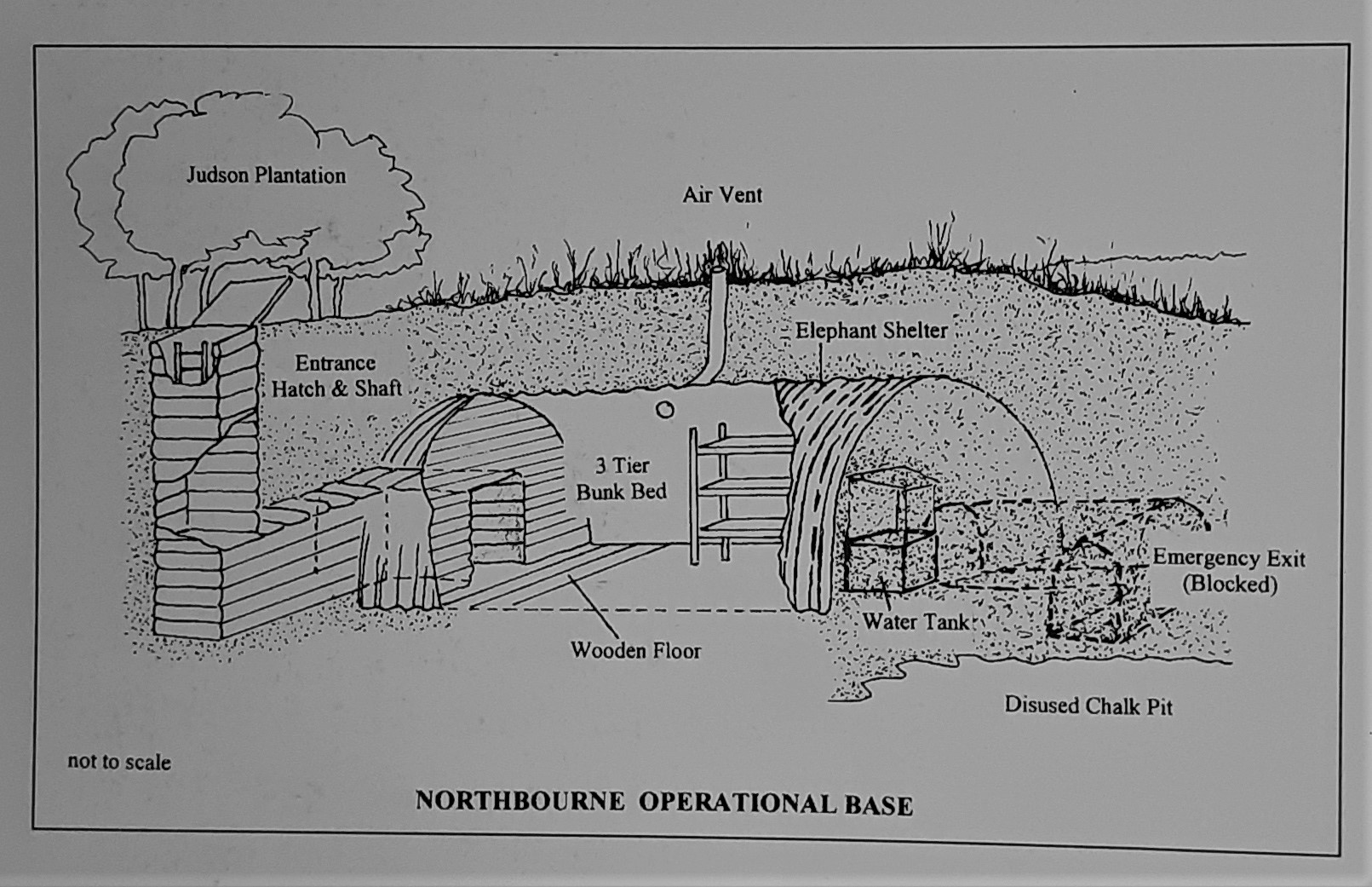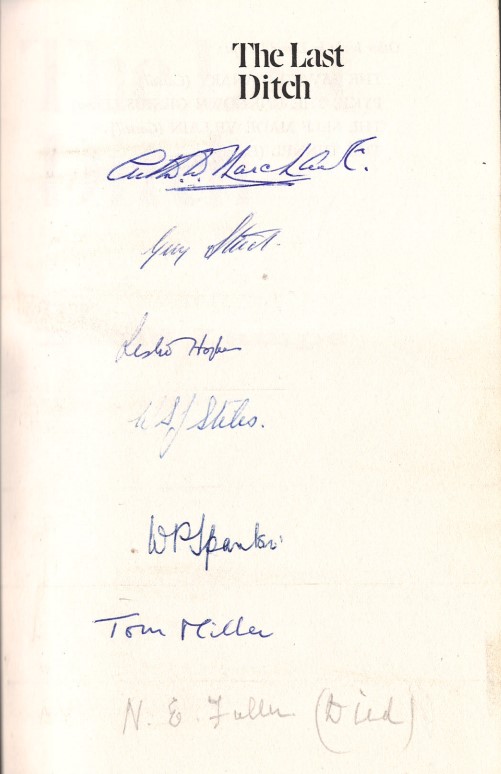The village of Sutton lies 3 miles south-west of Deal.
| Name | Occupation | Posted from | Until |
|---|---|---|---|
| Lieutenant Guy Pepper Steed | Farmer |
27 Jun 1940 | 03 Dec 1944 |
| Private Cyril William Densham | Farmer |
27 Jul 1940 | 24 Feb 1944 |
| Private Norman Ernest Fuller | Farmer |
18 Jun 1940 | 03 Dec 1944 |
| Private Leslie Norwood Phinn Hogben | Farmer |
10 Jun 1940 | 03 Dec 1944 |
| Private Leslie Charles Hyde | Teacher |
29 Jul 1941 | 08 Jun 1943 |
| Private Cecil Thomas Miller | Farmer market gardener & fruit grower |
30 Jul 1941 | 03 Dec 1944 |
| Private William Percival Spanton | Tractor driver |
24 Feb 1941 | 03 Dec 1944 |
| Private Walter Stephen Joffre Stiles | Farmer |
18 Jun 1940 | 03 Dec 1944 |
| Private Frank William Stone | Motor engineer |
14 Jul 1941 | 03 Dec 1944 |
The Patrol’s OB was in a plantation of larch trees near Telegraph Farm between Sutton and Betteshanger. It was built by the Royal Engineers. Located near a wood called Jaydens Plantation. This wood no longer exists and apparently the OB was destroyed in 1984.
Joff Stiles recalled: “It was an underground chamber inside a chalk pit filled with brambles. Most of the spoil was taken to another chalk pit and scattered. Some spoil was mixed with dead leaves and foliage and farmyard rubbish, such as old rusty metal and tins cans, to give the appearance of an old dump. It was squarish with a tunnel at each end. The entrance lid had wire netting woven with foliage and dead leaves to create a pile of leaves. Originally it was made with green and untreated birch uprights, but these started to rot, so we replaced them ourselves with iron uprights bolted together and sheets of corrugated iron. This was quite a job as we had to chip out the chalk again. It collapsed after the war when the plantation was grubbed up. We used it once a fortnight to ensure it was OK. We kept away from it at all other times to prevent being noticed. Some of the children from Northbourne knew the OB was under construction, so the Royal Engineers put the frighteners on them.
We had another one alongside the main Dover Road (A256) and there was a two-man Observation Post in an old strip of woodland on the Northbourne Estate. There was a big pine tree. The branches were taken off and drilled out. Steel pins were driven into the tree and the branches put back on. They looked dead.”
The OB was spotted as it was being constructed by two young boys out looking for bird's nests. The noticed the Army digging in the woods and knowing they would get into trouble if spotted they made a quick exit and it was only after the war one of them happened to come across the OB again. He recalled it as being built on sloping land with a trap door leading down a vertical shaft lined with wooden shuttering. This lead to a passage which made a right angled turn before opening out into a arched corrugated iron chamber with a wooden floor which housed bunk beds and a water tank set in a recess. A small chalk-cut escape tunnel turned at a right angle before ending in a dead end which was just chalk rubble which could easily be kicked away.
Sutton Patrol
The main targets were any tanks in Betteshanger Woods, plus whatever else came up within a two mile radius of the OB. They were trained to destroy supply dumps, aircraft, tanks, minefields and set booby traps for soldiers.
Joff Stiles; “In the event of an invasion we were to go on foot to the OB. We would let the enemy go by and then destroy supply dumps in the rear. We were very confident we could do the job. We would not have lasted long, maybe 10 days if lucky. Hopefully, we could have slipped away and escaped to our own lines. I am sure we would have been quite effective against supply dumps. We could easily move cross country and set light to gliders and plans using magnesium incendiaries. It would have been very difficult to set up an ongoing resistance organisation in this country as it is too small. There would not have been any equipment or supply routes. The Home Guard would have been wiped out."
Tom Miller; “We were a sabotage group. We were to destroy supply, ammunition and fuel dumps. There was no fuel here. All of the village garages were empty. The nearest supplies were at Sandwich which would have been destroyed by the Regular Army in the event of an Invasion, anyway.
We spent many training weekends at The Garth, using Thompson, Sten guns, grenades and explosives. There was a steam traction engine at The Garth, same weight and size as a tank. We would blow bits off it. There were lectures and demonstrations and we were given the 1937 Calendar; a little handbook that gave us the low down on how to make up unit charges, fuses, detonators and primers and that told us what explosives would do.
We went to Coleshill two or three times for intensive training. There were about 50 people from all over the country. One group would defend a target and another would attack. You would chalk your name and the time set to explode on the target.
Joff Stiles continues: “I never went to Coleshill. I did not have the time, what with ploughing, planting and harvesting. We trained almost every Sunday at The Garth and during the week with Cecil Lines’ unit at his place, Tappington Hall. I remember at The Garth when a grenade launcher exploded and seriously injured the trainer. We packed him full of bandages and took him to Canterbury. Cecil Lines lost a finger and thumb when a detonator exploded in his hand at Tappington. He had lit it but no flame was showing and then it went off. Very messy. We heard that one group was blown up in its OB, killing them all, when a gas cylinder was not switched off correctly and someone struck a match.
We also did shooting practice in a chalk pit, between Betteshanger and Northbourne, and practised blowing up trees for roadblocks. We used to shoot at sticks of gelignite stuck in tree branches. You have to remember there were very few people around in those days and explosions were common place, what with the Regular Army and air raids.
We regularly attacked Army units in the area. We would get in close enough to throw smoke grenades into buildings, gun emplacements and vehicles. We attacked an Army convoy, including armoured cars, at Nonnington. We blew up trees to block the road and threw in smoke grenades and thunderflashes. There was so much smoke that the RAF sent out a rescue team looking for a crashed plane. We also joined up with Norman Steed’s lot (Manston Patrol) for attacks on Manston Airfield. We chalked X on the aircraft tails. Training continued throughout the war without any slack."
Tom Miller; "We were not a fighting mob. We did not have any heavy weapons, only revolvers and explosives. We were told not to get involved in a direct fight with the enemy as we would lose. It was sabotage first, killing second. We were taught how to kill a man with a knife. We found the sticky bombs were useless as the slightest coating of dust prevented them from sticking, so we abandoned them as an idea. Most proud of our revolvers".
Joff Stiles; "We had a basic denim uniform but no insignia. If we were stopped by anyone, including MPs, we were to refer them to Southern Command Ashford and no-one else. We were armed with Thompson sub machine gun, .300 rifles, .38 Smith & Wesson long-barrelled revolver, .22 scoped rifle, Sten guns, knife, Plastic Explosives and gun cotton. We didn’t like the Sten as it would fire off the whole magazine in one go because the spring was too powerful. Guy Steed kept the explosives at his farm. We also had extra petrol coupons which were very handy indeed. Ammunition and guns were kept at home. I still have my copy of the 1937 Calendar.
We were expecting paratroopers and glider landings at any time. No warning. There was always the prospect of a sudden German landing to cause a distraction or even capture a town. There used to be barrage balloons all around Dover. Every now and then a German fighter would shoot one down. One day a whole load of fighters came across and shot them all down. We thought this is it! Something’s up. But nothing happened.
Towards the end of the war we were given new electric detonators. We wanted to try them out so I connected one to my car battery. Bang. Three holes in the radiator".
Tom Miller; “Some people were agog at being a member of a secret organization and would say they were going to a secret meeting. One of the Canterbury groups was a loud mouth. He would give a little bit away here and there until before long a non-member knew all about it and had to be recruited. It was a ridiculous situation. If anybody asked me what I was doing, including my family, I said I was in a Home Guard scout and signalling unit. It did not matter if we were not believed. We knew there were other groups because we had seen them at The Garth but we had no idea where they were based. We did not want to know what they were doing and we did not want them to know what we were doing.
We would have survived as long as we could. If we were sufficiently successful in upsetting the German’s invasion plans then the British might have driven them back into the sea. At Stand Down we received a letter from HQ. I got a little lapel badge later on. I was not disappointed at the lack of recognition. We allowed more troops to be sent to Normandy for D-Day. It was absolutely right at the time. Our great objective was to help win the war. We were proud to do our bit.”
Joff Stiles; “At Stand Down our weapons were collected one Sunday morning and that was that. We were thankful it was all over. No more training or evenings and weekends away. I only ever met one person wearing a lapel badge and that was in Horsham during the 1950s. For a few years after the war John Marchant (Ash Patrol) held a reunion at the Falstaff Hotel in Canterbury every November 5. The landlord belonged to Mount’s unit [It was actually Wally Gibson from Wickhambreaux Patrol]. We used to attach time pencils to the tables and chairs."
According to Joff Stiles originally the first groups set up by Peter Fleming all had animal names. They chose "Stoat". Later on, they were replaced by fruit and vegetable. Mr Stiles cannot remember if they were ever given another vegetable code name but paperwork retained by Captain Gardener suggests it was "Shallot".
In 1968 Percy Spanton got the remaining Auxiliers to sign his copy of The Last Ditch by David Lampe.
TNA ref WO199/3391 and WO199/3390
Hancock data held at B.R.A
Phil Evans
Adrian Westwood who was able to interview Tom Miller and Joff Stiles
Norman Bonney for Captain Gardener's papers
The Invasion that never was by Douglas Welby
David Steed, son of Norman Steed (Manston Patrol) and nephew of Guy Steed (Sutton Patrol)

